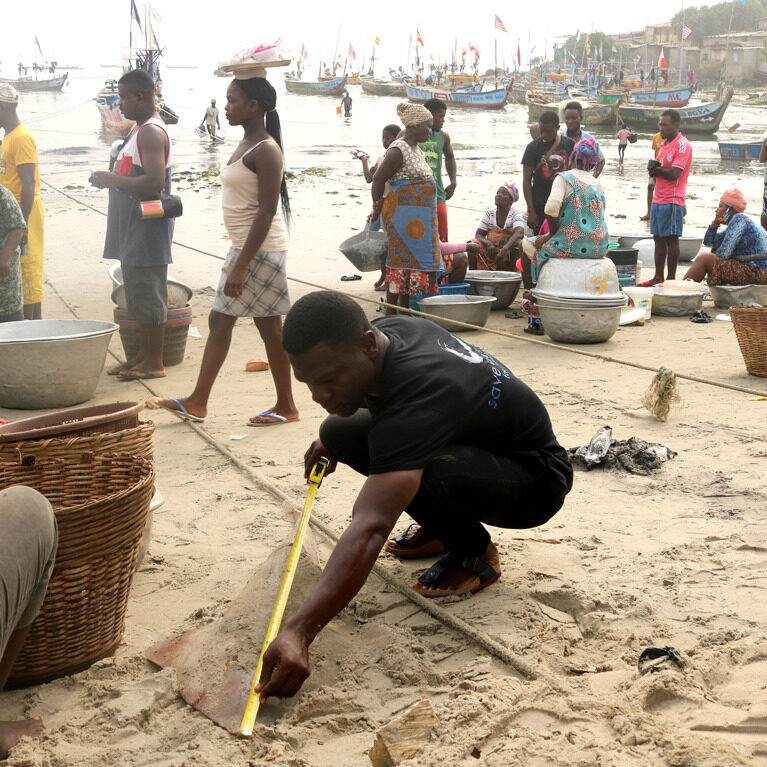Filling in the gaps for Ghana’s shark fisheries
By trawling the fish markets and landing sites of Ghana’s coastline, Issah is surveying the patterns in catch composition over time for sharks and rays in artisanal fisheries. In doing so, he is also raising awareness about the best fishing practices that safeguard sharks and rays and garnering fishers’ support for sharks and the conservation of ocean ecosystems in Ghana.
I am the founder and team leader of AquaLife Conservancy, a Ghana-based not for profit NGO dedicated to the research and conservation of marine and freshwater biodiversity. My current role at AquaLife Conservancy is to spearhead the research and conservation of sharks and rays in Ghana. I am leveraging the platforms AquaLife Conservancy has provided to train local volunteers and students to be champions of ocean conservation. In recent times, we have shown six students how to identify and monitor sharks and rays and how to conduct sampling protocols, and have tasked three of them to collect fisheries...
Filling in the gaps for Ghana's shark fisheries
This project aims to provide the first comprehensive data on ecology, biology, socio-economic and trade characteristics on guitarfishes, wedgefishes and sawfishes, and utilize community-driven conservation programs to garner community support for their conservation. The project will also organize stakeholders workshops aim at developing conservation strategy for the species in Ghana.
The proposed project is unique as it seeks to provide the first critically important and comprehensive baseline data on the ecology, biology, cultural, uses, socio-economic and trade dynamics of most-at-risk shark-like batoids in Ghana. With these data, local authorities will be able to devise effective and relevant management strategies and conservation initiatives to safeguard these species from extinction in Ghana. The project also aims to definitely confirm if indeed the two sawfishes (Pristis pritis and Pristis pectina) are extinct in the Ghanaian waters as they have been listed as Possibly Extinct according to the IUCN threat status. The project further aims to mitigate threats to shark-like batoids, other elasmobranchs and the associated marine habitat by extending and tailoring conservation education and awareness creation campaigns to key stakeholders in the fishing industry as well as children and youth-alike in their various coastal communities.
Extinction risk assessments reveal that sawfishes, wedgefishes and guitarfishes are amongst the most threatened marine fishes and are of global conservation concern. Wedgfishes and giant guitarfishes have recently overtaken sawfishes as the most-at-risk marine fish families globally. All but one out of the 16 species have been assessed as Critically Endangered and facing extremely high risk of extinction. Their traits encompassing limited biological productivity and presence in shallow waters, coupled with increasing pattern of exploitation, incentivized by the high demand for their lucrative fins and meat are key factors causing predominant decline of shark-like batoids populations worldwide. However, global conservation strategy released by the IUCN has resulted in a significant progress in raising global awareness and implementing management plans on the plight of sawfishes. Conservation strategy is yet to be developed for wedgefishes and guitarfishes but a call for urgent actions on them has been reported. Although, shark-like batoids still remain an important component in fisheries in the West African sub-region, their presence and status in fisheries across their ranges in the sub-region, and as such, Ghana are poorly studied. Though, there is anecdotal report gleaned from artisanal fishers that suggest sawfishes have not been observed and/ or caught in the marine waters of Ghana for decades, and a remarkable reduction in the catch stock of wedgefishes and guitarfishes, there is no scientific data to validate this claim. This lack of scientific data impedes effort to develop any comprehensive conservation strategy to protect these species. Consequently, the proposed project seeks to provide the first comprehensive scientific data on the ecology, biology, historical distribution as well as some insight into the uses, socio-economics and trade dynamics of shark-like batoids in Ghana.
- Survey and identify major elasmobranch fishing sites in Ghana and create fisheries profile encompassing catch locations, abundance, distribution, gear types, biological components (size, sex and maturity structure) and the socio-economics, cultural, uses and trade dynamics of shark-like batoids.
- Train and establish a network of 15 selected fishermen to collect long term citizen science fishery data on shark-like batoids and other threatened elasmobranchs in major elasmobranch landing sites.
- Conduct extensive community-driven and awareness creation campaigns on the plight of sharks and rays, and to organize stakeholders workshop aim at recommending practical strategies to support the management and conservation of these species.


